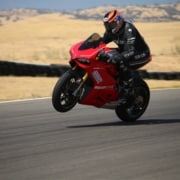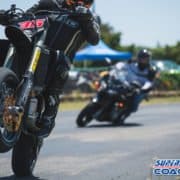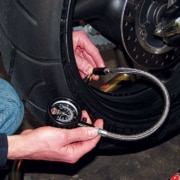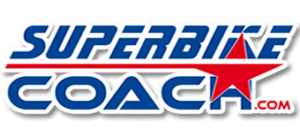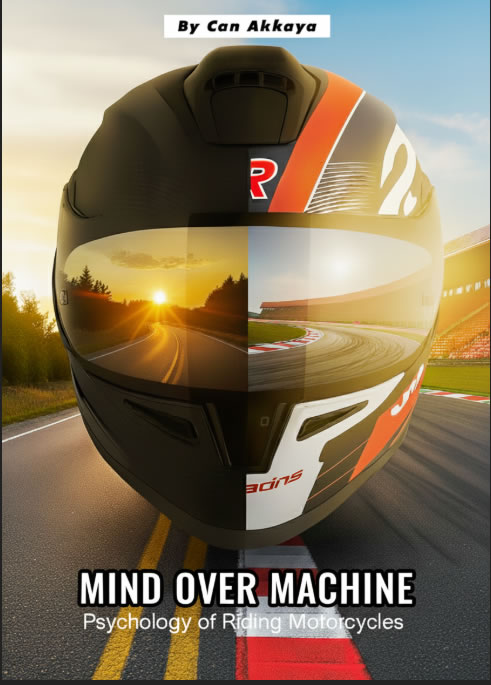Another bunch of motorcycle riders just graduated from our Cornering School Day 1 to 3, and finished the street rider part. Some of them will continue with the track/racing orientated part- Day 4 on 7/236/2017.
I am proud for each one of them. May the force always be with you! :-)
Headcoach Can Akkaya, Superbike-Coach Corp
Not many people talking about this actually , so here am I again with ‘another’ controversy, because I can’t keep my mouth shut about things which should have been said a long time ago. I’m looking forward to see in comments if the subject deserves to be ‘controversy’ in your eyes at all, so here we go…
How easy is it to make a motorcycle drivers license
In Europe as a kid of the 70’s, you had to make a drivers license and to ride a 50cc moped for 2 years. It cost 50 Euros, 6 classes and 1 riding hour. Don’t think you just open that motor to get 70 km/h hour out of it, because it was restricted by law to 25 km/h, so about 15 miles per hour! The cops new our games well, and it was not just costly to get caught… they could also locked your next drivers license step away for another year.
By the age of 16, you ramp up to 80cc lightweight bikes. The drivers license is comparable with the one for riding a moped, but comes with more required class and riding hours before you can make the driving test. That education cost about 1500 Euros, 11 riding hours and 24 hours of classroom! Those bikes are top speed restricted to 80 km/h, and you are riding them for another 2 years.
Now you’re 18, and since you went through a riding odyssey of 4 years- you are looking at another 400 Euros to get a drivers license to ride all kinds of motorcycles as long they are restricted to a maximum of 48 horsepower. You think that’s tough?!… there is more to come, because if you have crashes or fool around with the traffic laws- you will extent the 2 years period before you finally make it to a non-restricted motorcycle.
Now let’s say you are ‘mom-in-laws-favorite’ and stick tightly to the rules for another 2 years… yes, then it is time to make the A-license for another 1700 Euros, 12 hours of classroom and 11 hours of riding including a drivers test. Then… yes, finally then you are qualified to ride any motorcycle with all of its horsepower’s. At that point I should mention that when I was 20, that the entire motorcycle industry agreed with the laws to restrict the horsepower to ALL models to 100 hp maximum- to protect the riders from aggressive horsepower-marketing by the manufacturers. Makes kinda sense to me today, I must say. But I come back later to this once more. However, I don’t know if that ‘self-restriction’ is still ongoing over there, because I live in the country of my heart, the United States of America, since 2008 now.
Make a drivers license in California
So I had to renew my license as I emigrated and I didn’t complain hearing that I can make a motorcycle drivers license for only 28 bux. I mean… compared with the 3500 Euros I’ve spend… that’s a smile on the face right there. So I answered those funny questions in a written exam to get a temporary drivers license for 12 months… WHAT?! I mean… at least back then, nobody knew that Can Akkaya- a ex-racing pro from Europe, actually really can ride or not… right?!
Yes ‘I can’, but this is maybe like a ‘suicide permission’ or a ‘license to kill’ for someone else, because nobody (!) even asked me if I can ride… they just gave me a motorcycle drivers license. Just like that. I’ve passed my DMV circle riding test one week after my written exam. Maybe I was an exception getting so easy to a drivers license?… unfortunately not, but there are at least some more rider orientated looking options out there… but are they really?! Let’s see…
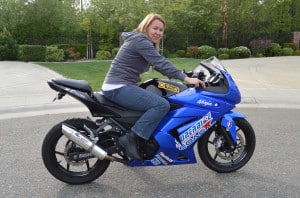
Anne signed up for my Basic Rider 1on1, which is designed to teach riders who don’t know how to ride AND who are not having a motorcycle drivers license yet. So I ask questions where she’s at and find out that she actually just achieved a drivers license, so I am referring her to my Road Skill 1on1 program which would be the logical next step. She had a hard time to make me understand that she need to learn from the scratch, and rejected my suggestions. My confusion… I am in a conflict thinking that a rider needs to learn from the scratch, even though the drivers license has been successfully mastered already. Feel me here?!
Since I don’t want to charge or offer a not suitable program, I offered to just transfer her Basic Rider to Road Skill after seeing her on a motorcycle and she would have to live with my decision… I was glad I didn’t! Anne-Marie was totally terrified and told me her story with that ‘certified school’ she took at some dealership parking lot:
I signed up for CMSP and I came into this class excited, I came out of this two day class as scared as I can ever be! I can’t even tell you how many times I dropped the bike, I lost count. And get this…. I passed!!!
Read Anne-Marie Pham’s full review here
What I’ve seen was a totally lost soul, but not ready to give up on a new hobby, and I had to win her trust first. I don’t even start talking about the curriculum what those schools have to go with, and which produces fears and hold backs towards braking. It was all showing- and shocked me a lot. Anne’s confidence grew by the hour, and she hired me for another Basic Rider session before I will give her my OK for the Cornering class, where she will learn all survival skills my way!
Comparing the European system with the regulations in the U.S., it seem to be bad for the economy over there and also it makes it hard to recruit new riders, because more and more kids are skipping the pain and just wait till they can drive their stupid VW Golf GTI once they are 18 years old. This is what this is all about friends… the economy. A ‘quick’ drivers license makes a quick sale. For me, this is almost like giving a new rider a unlocked gun and to say… “Just point it where ever you want- and this here is the trigger!”
Sure- if you would have asked me when I was 16, to make a drivers license for only 28 bux by pretty much answering 36 questions correctly and for doing some circles on a parking lot… I probably would have declared that day a Holiday, especially if you also would have told me that I could just go and pick a 210 hp liter bike right away! Would it been healthy for me?!… no it wouldn’t. Don’t you tell me you’ve done wise decisions from 14 till 25 years of age… so I didn’t, and so it would be not too bad if someone helps keeping things in check a little. The system has to change… now!
Headcoach Can Akkaya, Superbike-Coach Corp
I’m hearing it every day. First I see 99.9% of my students braking, and their performance is actually shockingly bad. Straight up… ‘BRAKING’ IS THE PRIOR SKILL TO STAY ALIVE. Then I ask them who taught them and what was the message, and their answers are even more shocking…
In fact, ANY curriculum of motorcycle drivers license giving institutions are telling new riders to “Stay away from the front brake when turning/leaning!” I believe that this is already a CRIME to say, because I would say that you gotta be be able to make a use of your brakes AT ALL FREAKING TIMES! But there is much more coming with this message- mental blockades which I as a Coach who is teaching the total opposite- have to remove manifested habits and overly produced fears!
Now how is that?!… well, if you tell a new rider stuff like that- you automatically manifest a certain hold back towards the front brake, which is actually our primary weapon against scary situations. The blockade is so deep in their heads, that most of the riders are not even using 50% of their front brake potential- which is another guarantee to get hurt or even to die. Besides this, it also leads them to an over-usage of rear brake which causes even more confusion and extends their learning curve… which is time they might don’t have.
You think a street rider don’t need this?… You’re dead wrong! Superbike-Coach teaches ‘Trail Braking’, a MotoGP riding technique since 10 years in Cornering School Day 3, and that is the key to lots of good things the top racers of this planet take advantage of. Priority for them… to lower lap times- and for the street rider to gain the chance to SURVIVE dramatically. Why and how?… find out in the class and learn it, because reading and learning won’t work here.
Is this a guarantee to get out of everything?… no it’s not, because there is always a ‘point of no return’, but it gains you chance to make it exponentially. Are there other schools teaching to trail brake?… probably- are they doing it right?… I don’t know. I do know that Superbike-Coach does it right- and that we have the environment and drills to do this even better. The curriculum and their message in this regard of license giving institutions has to change, because it is wrong and dangerous.
Headcoach Can Akkaya, Superbike-Coach Corp
Can Akkaya Report, Knee Down & Wheelie Course last weekend
Knee Down class, 4/29/2017

The second session shows who still needs hands on, and since I let only 2-3 riders in my track oval- the personal attention is big. From the 3rd session on the knee pucks got grounded, and more and more students are finally got it done. Assistant Coach Brian Hunnicutt had to replace Superbike-Coach photographer Dean Lonskey, who couldn’t make it. He did a great job as his featured pics are demonstrating. In the end of the day, about 65% of the students got their knee down, by gaining safety and speed! We also got some feedback and get the waiting time down by half with the next knee down class on 8/13/2017
Wheelie Course, 4/30/2017

I lost my voice coaching 1on1 on the radio to students when Marion Akkaya put them on the seat of my AMA spec Supermotard with a mounted wheelie-bar which I designed (picture right, patent ongoing). Assistant Coach Brian Hunnicutt instructed them accordingly when the students applied what they’ve learned on their own bikes or our wheelie rental bike, which also has one of my wheelie bars mounted and comes with much more riding time as well.

The action on our Mini-Bike couldn’t be more fun, and the way how we want our students make their wheelie attempts helps them tremendously before they are going back to their own bike- even if they don’t even realize it in the first place. But the throttle control and timing- not to forget to break fears, is what this is all about. Our motto… if you don’t break it… you’re not trying hard enough- and we’re fine with it!
Straight up… a 60% success rate and NO crashes- that shows we deliver. Yea, unfortunately not everyone makes it, but that’s the nature of ALL things in life, isn’t it?
Superbike-Coach photographer Dean Lonskey was back to shoot the wheelie course, and I must say that this here is my absolute favorite shot for now (all featured pics). I guess we get to see much more like this once he has them all on the server, ready for FREE download for all students.
One of the most commonly asked questions you see on the net is “what tire pressures should I run for and with the emphasis that’s put on having the correct pressures both at and away from the track it’s no wonder.
Having the right pressure for rider, bike and tire combination is very important to getting the most out of your tires both in terms of performance and longevity. As I’m sure you know tires are very expensive, so making sure we get the most out of them by having the correct pressure and therefore avoiding bad wear should be a priority for all track day riders.
The trouble is there is no one magical pressure for one type of motorcycle or type of tire, and as you’re about to find out there are times when you would even use different pressures for the same tire on the same bike!
So to help you understand what actually goes into determining the best pressure here’s a look at some of the things that affect tire pressure.
Things that Affect Tire Pressure
Weight –Someone heavier is going to create a larger contact patch on the ground which could overheat it and cause nasty wear. And vice versa, the lighter rider using the heavier rider’s pressures won’t have a contact patch big enough, so they won’t get enough heat into the tire and again you’ll see another sort of nasty wear. This problem is made worse if your suspension isn’t properly set up for your weight.
Tire Construction – Some tires have harder carcasses and sidewalls which mean they don’t need to run as high a pressure as a tire with a soft carcass.
Ambient Temperature – The outside temperature is going to affect how your tires heat up. Setting your rear to 30psi on a cold day isn’t going to give you the same performance as setting it at the same pressure on a baking hot day, because on a hot day the tire will heat up quicker and by more.
Some of the fast riders and racers actually change their pressures throughout the day to compensate for the change in temperature so they can maximize the performance of their tires.
Hot and Cold Pressures – If you set your pressure to 30psi when the tire is cold, this isn’t going to be the same as setting them to 30psi when the tire is hot. A cold tire will gain around 2-6psi (depending on your pace) through use on the track because it will heat up and so will the air inside, meaning the pressure will increase.
Road vs Track Tires – Road tires are typically designed to run at higher pressures than track tires because they are not expected to heat up as much.
As you can see, there are many factors that come into finding the best tire pressure for your bike and tire combination. Right now you may be wondering how on earth you get the right pressures, and I wouldn’t blame you, so here we go.
How can I find my best pressure?
What you want first is a good baseline pressure which you should be able to get from any of the below sources.
Manufacturer – Go direct to the manufacturer and get the pressures they recommend, you can usually find them on their website. If not, email them and ask what they would recommend setting tire ‘X’ to for use on the track. They’re usually pretty helpful with stuff like this.
Tire Expert – Speak to the tire supplier at the track, or talk to someone you know who deals with tires and setting up bikes for the track. They would have experienced many tire and bike combinations, so they know their stuff.
Other riders – See what other riders with similar setups are doing with the same tires. They too would have gone through the same process to find the best pressures for themselves, so they should be able to set you off close to where you need to be.
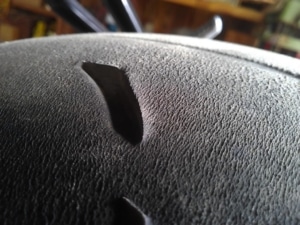
Once you have your base pressure, try it out and see how you get on. Did you notice any unsavory reactions from the tire that wasn’t there before? Or the more common issue, is the tire showing any signs of unnatural wear? If you answer yes to these questions then it could well be that your pressure is not quite correct.
Last Few Tire Pressure Points Worth Mentioning
When should you set your pressures? – If you have tire warmers then set them once they have been in the warmers for a good 45 minutes or so (from stone cold). If you don’t have warmers then set them cold first thing in the morning, but remember that your tires will gain a few psi so try to take that into account. Once you’ve done a couple of sessions you’ll be able to see how much psi you’re really gaining and whether or not you are near where you want to me.
Just keep an eye on the tires. If they’re showing any sort of unnatural wear then you will need to adjust your settings.
Is your pressure gauge calibrated? – You probably shrugged your shoulders at this one, but it’s not that hard to do. Just ask the tire expert at the track to set your tires to a given pressure using their compressor, then use your gauge to check it reads the pressure they just set it to. You can also check it against one or two other rider’s gauges to see if they give the same readings. If you can, change the dial to show the compensation, if you can’t (more likely) just make a note so you remember the difference.
Wet weather riding – You want to make sure you’re pressures aren’t too low for wet weather riding, be it proper race wets or road tires. If the pressure gets too low then the tread will compress which means it can’t clear water effectively.
Lastly, don’t overdo it. I know I mentioned some of the factors that come into play with getting the best tire pressure, but this was to demonstrate that there’s not a one size fits all pressure. Don’t get too hung up on trying to get the pressure perfect.
Unless you’re pushing on at the higher end of the fast group then you probably wouldn’t notice the small differences that come from things like changes in temperature throughout the day or the way you set your pressures initially. If you feel grip and you’re not showing any ugly wear patterns then that’s all you really need to worry about.
Thanks to Dan Netting for this excellent line up.
Another 30 riders have made it from Day 1 to Day 3 through out our Cornering School program
They were surprised how much more than a ‘motorcycle rider training’ this is. Here is Thomas Young Yelp review:
This course is so many things. I’ve attended Corning 1 through 3. They were fun. They were hard. They were rewarding. Although it was only 3 days of riding on a great little track. I now have the tools and understanding to improve my mental and physical riding skills. It has truly given me the confidence to be a better rider. After every class I had new skills it work on. It’s not a class that you ride away thinking Now I’m a great rider. But a feeling that I am a better rider right this minute and have tools to become an even better rider every time I get on the bike. I’m very competitive and was pushing myself and the bike above my skill level just to try and be the fastest. I wasn’t learning a thing. Just going out and scaring myself and most likely everyone else. Coach slowed me down had me do some drills. He explained why they were important. Not just do this and go faster or ride safer. But Why and How doing things his way (the only way haha) work. And guess what? I ride so much faster. But it’s not scary. It’s challenging and I understand what’s going on. I can trust myself and the bike. Don’t get me wrong about the scary, it can still happen. But the fear is gone. I can to push to scary FUN. Thank you coach. Looking forward to more time in the class room. But also some tracks days having fun playing on toys that go fast.
Thomas Young
As usual- Superbike-Coach photographer Dean Lonskey has picked some featured pictures of a truly special class, last Sunday’s Cornering School Day 3. This is the FREE download link: http://www.dlonskeyphoto.com/Superbikecoach-Gallery/Cornering-School-Days-1-4/Cornering-School-Day-3/CSD3-April-9-2017/CSD3-FEATURE-PICS/
Headcoach Can Akkaya

